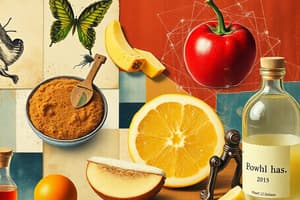Podcast
Questions and Answers
Which of the following best describes the role of food technology?
Which of the following best describes the role of food technology?
- The use of culinary arts to create new recipes.
- The study of consumer food preferences and market trends.
- The application of food science to the selection, preservation, processing, packaging and use of safe, nutritious, and wholesome food. (correct)
- The genetic modification of crops to increase yield.
What historical event significantly propelled the development and use of canning as a method of food preservation?
What historical event significantly propelled the development and use of canning as a method of food preservation?
- The Great Depression.
- The invention of the refrigerator.
- World War I and World War II. (correct)
- The Industrial Revolution.
A food manufacturer is looking to implement innovative food technology solutions. Which strategy would contribute to this goal?
A food manufacturer is looking to implement innovative food technology solutions. Which strategy would contribute to this goal?
- Increasing the use of synthetic additives to enhance flavor.
- Focusing solely on lowering production costs, regardless of environmental impact.
- Developing new methods of food production that reduce waste. (correct)
- Ignoring food safety regulations to expedite the production process.
When evaluating overall food quality, which of the following factors is taken into consideration?
When evaluating overall food quality, which of the following factors is taken into consideration?
How does food processing contribute to making food products more accessible to consumers?
How does food processing contribute to making food products more accessible to consumers?
Which of the following is an example of a food preservation technique?
Which of the following is an example of a food preservation technique?
Food spoilage can result from several factors. Which of the following contributes to food spoilage?
Food spoilage can result from several factors. Which of the following contributes to food spoilage?
What is the primary focus of food security?
What is the primary focus of food security?
What category does 'Food Microbiology' fall under in the context of food science?
What category does 'Food Microbiology' fall under in the context of food science?
Which area of study within food technology focuses on adverse reactions to food?
Which area of study within food technology focuses on adverse reactions to food?
According to the definitions provided, what distinguishes a 'food additive' from a typical food ingredient?
According to the definitions provided, what distinguishes a 'food additive' from a typical food ingredient?
What is the primary reason for using food additives in modern food production?
What is the primary reason for using food additives in modern food production?
Which of the following describes how preservatives function as a food additive?
Which of the following describes how preservatives function as a food additive?
What role do food additives play in meeting consumer demands?
What role do food additives play in meeting consumer demands?
Which of the following is an example of a 'man-made version' of a food additive?
Which of the following is an example of a 'man-made version' of a food additive?
What is the primary function of preservatives in food products?
What is the primary function of preservatives in food products?
Why are antioxidants added to foods that are high in fats and oils?
Why are antioxidants added to foods that are high in fats and oils?
Which of the following statements accurately describes the use of food colorings?
Which of the following statements accurately describes the use of food colorings?
What is the main purpose of using color additives in food production?
What is the main purpose of using color additives in food production?
What is the function of flavor enhancers in food?
What is the function of flavor enhancers in food?
Which of these exemplifies why flavorings are added to food?
Which of these exemplifies why flavorings are added to food?
What is the purpose of anticaking agents in food production?
What is the purpose of anticaking agents in food production?
In which type of food product is an antifoaming agent typically used?
In which type of food product is an antifoaming agent typically used?
What role do thickening agents play in food production?
What role do thickening agents play in food production?
A food additive is deemed safe for use only if
A food additive is deemed safe for use only if
Which consideration is crucial regarding the use of food additives in infant formula?
Which consideration is crucial regarding the use of food additives in infant formula?
What guidance is typically given to the public regarding the consumption of food additives?
What guidance is typically given to the public regarding the consumption of food additives?
What distinguishes food technology from other fields of food science?
What distinguishes food technology from other fields of food science?
Besides rationing in wartime, what other factor drove the increased use of canning during World War I and World War II?
Besides rationing in wartime, what other factor drove the increased use of canning during World War I and World War II?
Alongside reducing wastage, what is another way to create innovative food technology solutions?
Alongside reducing wastage, what is another way to create innovative food technology solutions?
Which component of food technology relates to understanding and managing potential hazards in food?
Which component of food technology relates to understanding and managing potential hazards in food?
Among the biggest trends in food technology, what does the rise of 'free from' products refer to?
Among the biggest trends in food technology, what does the rise of 'free from' products refer to?
Which of the following represents a promising emerging trend in the realm of food technologies?
Which of the following represents a promising emerging trend in the realm of food technologies?
What role does moisture play as a component of the chemical content for food?
What role does moisture play as a component of the chemical content for food?
What is the purpose of pasteurization in food preservation?
What is the purpose of pasteurization in food preservation?
How does sovereignty relate to food security?
How does sovereignty relate to food security?
Why is it important to control the atmosphere for food safety?
Why is it important to control the atmosphere for food safety?
Flashcards
Food Technology
Food Technology
The application of food science to selection, preservation, processing, packaging, and use of safe, nutritious, and wholesome food.
Canning history
Canning history
A method of food preservation that greatly increased during World Wars I & II due to rationing, advanced techniques, and awareness of food safety.
Food Technology Solutions
Food Technology Solutions
Reducing wastage, improving safety/quality, developing new methods, improving production efficiency and improving access.
Components of Food Technology
Components of Food Technology
Signup and view all the flashcards
Trends in Food Technology
Trends in Food Technology
Signup and view all the flashcards
New Food Technologies
New Food Technologies
Signup and view all the flashcards
Food definition
Food definition
Signup and view all the flashcards
Chemical Content of Foods
Chemical Content of Foods
Signup and view all the flashcards
Food Quality
Food Quality
Signup and view all the flashcards
How to Measure Food Quality
How to Measure Food Quality
Signup and view all the flashcards
Food Processing
Food Processing
Signup and view all the flashcards
Food Processing Technologies
Food Processing Technologies
Signup and view all the flashcards
Food Preservation
Food Preservation
Signup and view all the flashcards
Food Spoilage
Food Spoilage
Signup and view all the flashcards
Food Security
Food Security
Signup and view all the flashcards
Food Additives
Food Additives
Signup and view all the flashcards
Codex Alimentarius definition
Codex Alimentarius definition
Signup and view all the flashcards
Need for Food Additives
Need for Food Additives
Signup and view all the flashcards
Functions of Food Additives
Functions of Food Additives
Signup and view all the flashcards
Importance of Food Additives
Importance of Food Additives
Signup and view all the flashcards
Types of Food Additives
Types of Food Additives
Signup and view all the flashcards
Preservatives
Preservatives
Signup and view all the flashcards
Antioxidants
Antioxidants
Signup and view all the flashcards
Food Colors
Food Colors
Signup and view all the flashcards
Why use Colour Additives?
Why use Colour Additives?
Signup and view all the flashcards
Why use Food Flavorings?
Why use Food Flavorings?
Signup and view all the flashcards
Flavor Enhancers
Flavor Enhancers
Signup and view all the flashcards
Anticaking Agents
Anticaking Agents
Signup and view all the flashcards
Antifoaming agents
Antifoaming agents
Signup and view all the flashcards
Glazing agents
Glazing agents
Signup and view all the flashcards
Why Food Additive Safety?
Why Food Additive Safety?
Signup and view all the flashcards
Advice to the public of food additives
Advice to the public of food additives
Signup and view all the flashcards
Study Notes
- Food technology applies food science to select, preserve, process, and package food, ultimately ensuring it is safe, nutritious, and wholesome.
History of Food Technology
- Canning became a prevalent food preservation method due to World War I and World War II.
- Canning's rise was driven by the need for rationing, advancements in techniques, and a greater understanding of food safety.
Components of Food Technology
- Food analysis and chemistry are key components.
- Measurement of food quality factors is crucial.
- Food processing and engineering plays a significant role.
- Addressing food spoilage and toxicology is essential.
- Controlling the atmosphere where food is kept is important for food safety.
Definition of Food
- It is any substance consumed to provide nutritional support for an organism.
- Food sources: plants, animals and fungi.
Chemical Content of Foods
- Chemical contents include moisture, carbohydrates, fats/lipids, proteins, vitamins, and minerals.
Food Quality
- Food quality represents the linked properties that define food, indicating its degree of excellence through taste, appearance, and nutritional content.
How to Measure Food Quality
- Appearance factors are assesed.
- Chemical evaluation is carried out.
- Microbiological evaluations are performed.
Food Processing
- Food processing transforms raw materials into food or other forms through physical or chemical methods.
- Results in a more marketable final food product easily prepared and cooked from raw material.
Food Preservation
- Food preservation prevents spoilage post-harvest or during storage.
- Freezing, chilling, canning, pasteurization, heating methods, moisture control, and irradiation can be used for preservation.
Food Spoilage
- Food spoilage involves changes in the physical and chemical content of food.
- These changes stem from microbes, insects, and natural enzyme degradation.
Studying That Suits You
Use AI to generate personalized quizzes and flashcards to suit your learning preferences.




